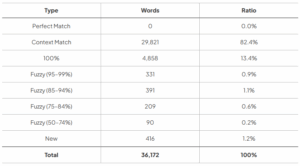

Reducing Localization Costs by Over 90% Through Strategic TM Management and Content Reuse
For global manufacturers competing in fast-moving markets, frequent product updates and regional model variations are the norm. With dozens of language versions required for each model—often under tight launch schedules—multilingual manual production quickly becomes complex and cost-intensive. Even when translation workflows are mature, the speed and scale of product release cycles often result in rising localization costs. Hansem Global implemented a scalable content strategy focused on controlling source content, maximizing TM leverage, and optimizing content reuse—minimizing new translation volume to just 1–2% per product manuals while accelerating delivery without compromising quality.
Project Summary
Client: Leading global smartphone manufacturer (confidential)
- Industry: Consumer Electronics – Mobile Devices
- Markets: U.S., Asia, Europe
- Languages: 50+
- Scope: End-to-end user manual production and localization for multiple product variants, including regional customizations
- Key Service Areas:
· Source content planning, authoring, and structured writing
· Translation memory (TM) management and optimization
· Multilingual localization and regulatory compliance
· Derived manual production based on core documentation
· Glossary and style guide governance across languages
· Design, multilingual DTP, and print-ready asset delivery
· Responsive digital manual publishing for mobile, tablet, and web platforms
Challenges
Operating in a highly competitive market with frequent product launches, the client faced several complex challenges in multilingual documentation production:
- Zero-error tolerance: The client expected flawless quality, even for last-minute changes.
- Compressed timelines: Fast product cycles and simultaneous global launches drove tight localization deadlines.
- Frequent content revision: Ongoing software updates during manual development meant translators had to repeatedly revise already localized content.
- Last minute market-specific content: Content like legal disclaimers or regulatory notes was often introduced late, added directly into target translation, and required manual updates to translation memory to ensure consistency and future reuse.
- Rapid expansion of language list: the client’s global reach accelerated. With new languages being added almost every year, the scale and complexity of multilingual manual production grew exponentially—placing additional strain on content tracking, TM maintenance, and process governance.
- Lack of structured governance: Without a standardized content reuse and modularization framework, managing documentation across multiple product variants and regions relied heavily on manual coordination—leading to complex translation workflows, increased communication, and more rigorous quality control.
Despite having experienced teams and structured manual processes, the growing complexity led to higher risks of human error and inefficiencies that were difficult to fully eliminate.
Our Solutions
To address the growing complexity and cost of multilingual manual production, Hansem Global implemented a scalable, TM-driven content reuse strategy that enabled efficiency without sacrificing quality or compliance.
Key actions included:
- Built a stable core manual
Developed a foundational source manual with a consistent structure, reducing the need for full rewrites across product variants.
- Enforced sentence-level content reuse
Writers reused or minimally edited existing expressions by referencing a controlled sentence database—maintaining consistency and maximizing TM match efficiency even when updates were scattered throughout the manual.
- Centralized TM and terminology management
Maintained consistency across 50+ languages and vendors by unifying translation memory and terminology databases.
- Established TM governance workflows
Created processes to track and reuse regulatory or region-specific content—even if added only in target languages.
- Formed dedicated teams
Assigned specialized writers and translators to ensure content consistency and brand alignment across product generations.
- Manually maintained TM post-revision
Updated translation memory after each late-stage change, including content added directly in the target language.
- Deployed specialized QA team in the final production stage to:
✓ Confirm alignment between the UI and localized manuals
✓ Validate inclusion of regional regulatory content
✓ Enforce a zero-error policy through comprehensive pre-release reviews of all language versions
This approach significantly reduced redundant translation, improved quality control, and created a sustainable foundation for scaling documentation across dozens of markets.
Outcome
Quantitative Results
Hansem Global’s derived manual strategy delivered measurable impact in quality, speed, and cost:
- Zero critical errors for nearly 20 years, even across high-volume multilingual production. Minor issues were proactively caught and resolved during final QA review.
- Enabled simultaneous publishing in 50 languages—both print and responsive digital formats—for a 200-page manual within 4 weeks.
- Achieved over 90% reduction in new translation volume, thanks to strategic reuse and TM discipline.
- Significant cost savings through reduced translation workload and efficient TM matching, even as language coverage expanded from 6 to over 50.
- High TM leverage maintained even for frequently updated models:
✓ Strategy model:8% leveraged matches
Chart 1. Strategy Model TM Match Analysis✓Derived model:9% leveraged matches
Chart 2. General Model (Derived) TM Match Analysis
Qualitative Impact
- Shifted from reactive editing to strategic content management with clear governance for content reuse.
- Shorter review cycles due to fewer segments needing linguistic validation.
- Improved TM performance from continuous post-editing updates and feedback loops.
- Minimized human error, even in late-stage updates, through dedicated QA teams verifying regulatory and UI alignment across all languages.
Final Thought
If your team is producing multiple manuals annually—across dozens of languages and product variants—now may be the time to reassess your documentation strategy.
By adopting a structured content reuse model, supported by disciplined translation memory management and governance, you can achieve sustainable efficiency and reduce risk—without compromising on quality.
Let’s explore what this could mean for your organization.





